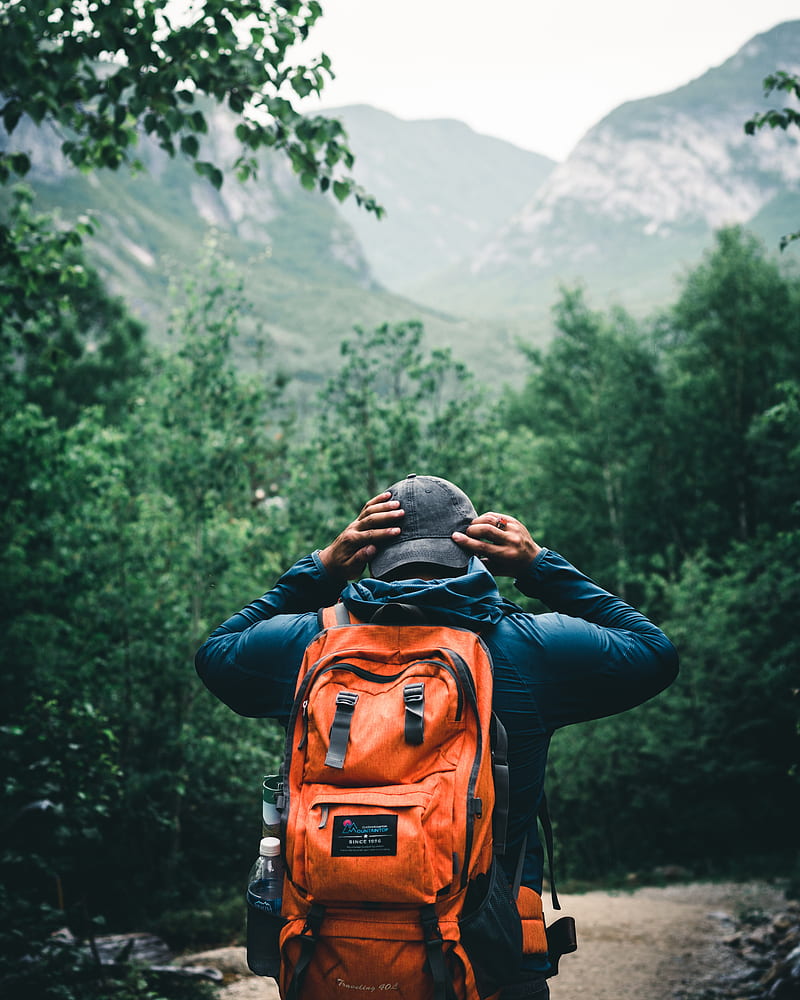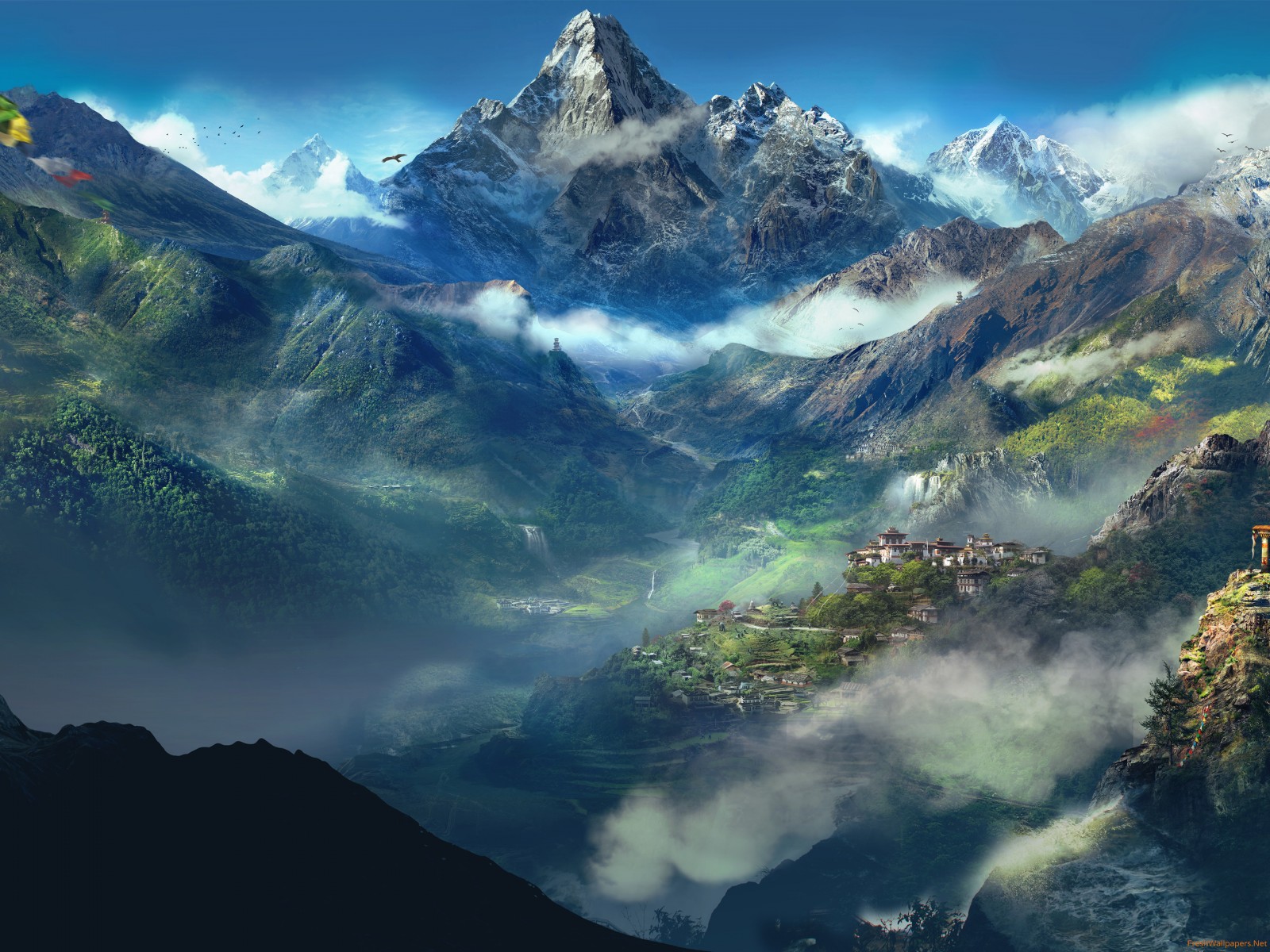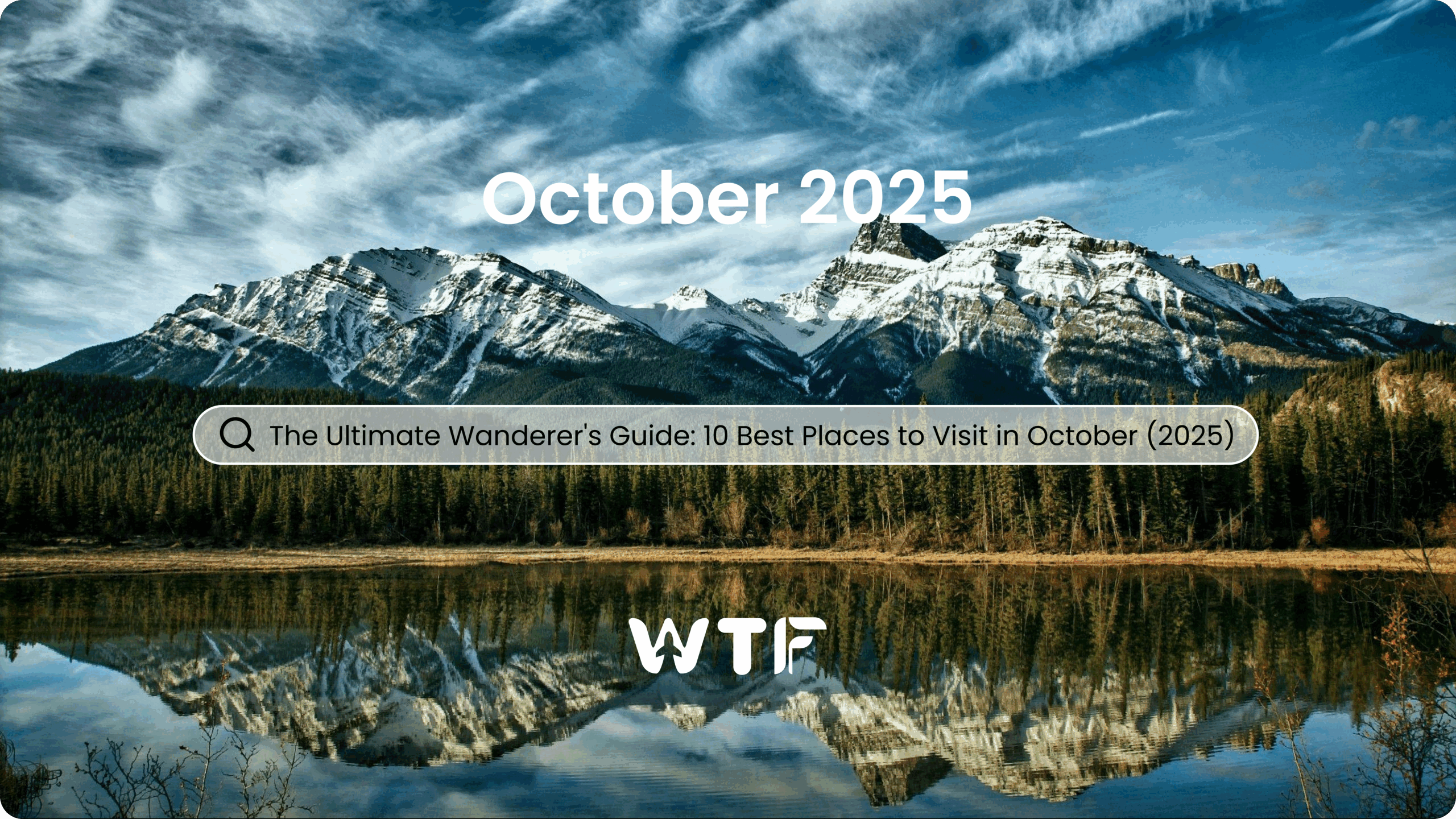Explore Andorra with WanderingTooFar.com: Unveiling the Splendor of Europe’s Best-Kept Secret! Join us on a virtual journey as we unravel the mysteries of this small yet enchanting country tucked away in the heart of the Pyrenees. From its picturesque villages to adrenaline-pumping outdoor adventures, get ready to immerse yourself in the essence of Andorra. Let us be your guide as we uncover the hidden treasures and unforgettable experiences awaiting you in this captivating destination. Start planning your next adventure with us today!
Overview Of Andorra:
Andorra, officially known as the Principality of Andorra, is a small country located in the eastern Pyrenees mountains of Europe. It is bordered by France to the north and Spain to the south. Despite its small size, Andorra is a landlocked country with no coastline. It is situated between the regions of Catalonia in Spain and Occitanie in France.
- Small Size: Andorra is one of the smallest countries in the world, with an area of just 468 square kilometers (181 square miles).
- Population: Despite its small size, Andorra has a population of around 77,000 people (as of 2022).
- High Life Expectancy: Andorra has one of the highest life expectancies in the world, with an average life expectancy of over 80 years.
- No Airport: Surprisingly, Andorra does not have its own airport. The closest airports are located in neighboring countries, Spain and France.
- Tax Haven: Andorra is known for its status as a tax haven, with low taxes attracting shoppers and investors from neighboring countries.
- Official Language: Catalan is the official language of Andorra, reflecting its close cultural ties with Catalonia.
- Skiing Paradise: Andorra is a popular destination for winter sports enthusiasts, boasting several ski resorts with excellent facilities and slopes.
- Longevity: Andorra has one of the highest proportions of centenarians (people aged 100 or older) per capita in the world.
- No Military: Andorra is one of the few countries in the world with no standing army. Defense is the responsibility of neighboring countries, primarily France and Spain.
- Ancient Roots: The history of Andorra dates back to the time of Charlemagne in the 9th century when the region was established as a feudal territory ruled jointly by the Bishop of Urgell and the Count of Foix.
Unlocking Andorra’s Diary: What Makes its Landscapes, History & Culture Unique?
Geography
Andorra’s geography is characterized by its stunning mountainous terrain, deep valleys, and pristine rivers, making it a paradise for outdoor enthusiasts.
The country is dominated by the Pyrenees mountain range, which runs along its northern border with France. These mountains, including peaks like Coma Pedrosa, reach heights of over 2,900 meters (9,500 feet) above sea level, providing breathtaking vistas and challenging terrain for adventurers.
Nestled within these mountains are lush valleys, such as the Madriu-Perafita-Claror Valley, a UNESCO World Heritage Site known for its natural beauty and biodiversity. These valleys offer serene landscapes for leisurely hikes and picnics amidst nature’s splendor.
Andorra’s numerous rivers, including the Valira and the Riu Runer, flow through its valleys, carving deep gorges and providing opportunities for freshwater activities like fishing and kayaking.
One of the biggest draws to Andorra’s natural landscapes is its abundance of outdoor activities. Hiking is a popular pastime, with trails ranging from gentle walks through scenic valleys to challenging ascents up rugged peaks. The country boasts over 290 kilometers (180 miles) of marked hiking trails, catering to all skill levels.
In the winter months, Andorra transforms into a snowy wonderland, attracting skiers and snowboarders from around the world. With top-notch ski resorts like Grandvalira and Vallnord offering extensive slopes and modern facilities, visitors can enjoy world-class skiing and snowboarding experiences.
During the warmer months, mountain biking takes center stage, with an extensive network of trails crisscrossing the landscape. Whether you’re a novice cyclist or a seasoned mountain biker, Andorra offers trails suited to all abilities, providing exhilarating rides through breathtaking scenery.
Historical Information:
Andorra’s history is rich and diverse, shaped by its unique position between France and Spain in the Pyrenees mountains. Here are some historical details about Andorra:
- Early Settlements: Evidence suggests that Andorra has been inhabited since prehistoric times, with traces of human presence dating back to the Neolithic period.
- Feudal Origins: Andorra’s modern political system traces its roots to the 9th century, when Charlemagne granted the region to the Count of Urgell and the Bishop of Urgell. This established a feudal system of governance that endured for centuries.
- Co-Principality: In the 13th century, a feudal agreement known as the Pareage was established between the Count of Foix (later the French ruler) and the Bishop of Urgell (representing the Spanish bishopric). This agreement created the unique co-principality of Andorra, with shared sovereignty between France and Spain.
- Codification of Laws: In 1278, Andorra’s legal system was formalized with the signing of the Pareage, which established the principles of Andorran law and governance. These laws, known as the “Pariatges,” were revised and updated over the centuries to reflect changing political and social realities.
- Role of the Co-Princes: The President of France and the Bishop of Urgell continue to serve as co-princes of Andorra, a symbolic role inherited from historical tradition. However, the day-to-day governance of Andorra is managed by a democratically elected parliament and executive council.
- Isolation and Autonomy: Due to its remote location in the mountains, Andorra remained relatively isolated for much of its history. This isolation contributed to the preservation of its traditional culture and customs, including the Catalan language and folk traditions.
- Modernization and Tourism: In the 20th century, Andorra underwent significant modernization, particularly with the development of its tourism industry. The construction of ski resorts and infrastructure improvements helped transform Andorra into a popular destination for winter sports enthusiasts and holidaymakers.
- Political Changes: Andorra has gradually transitioned from its feudal past to a modern parliamentary democracy. In 1993, the country adopted a new constitution, establishing a system of government based on the principles of democracy, rule of law, and respect for human rights.
- Cultural Heritage: Despite its small size, Andorra boasts a rich cultural heritage, including Romanesque churches, traditional festivals, and folk music. The preservation of Andorran culture remains an important aspect of national identity.
- European Integration: Since the 20th century, Andorra has increasingly integrated into the broader European community. It is not a member of the European Union but maintains close economic and political ties with neighboring countries and participates in various European initiatives.
Culture:
Andorra’s culture is a vibrant tapestry woven from its rich history, stunning landscapes, and diverse influences. Here are some key aspects of Andorran culture:
- Catalan Influence: The predominant cultural influence in Andorra is Catalan, reflecting its close ties with Catalonia, Spain. Catalan is the official language of Andorra, spoken by the majority of the population, and it plays a significant role in shaping Andorran identity, literature, and arts.
- Folk Traditions: Andorra has a rich tradition of folk music, dance, and festivals that celebrate its cultural heritage. Traditional Andorran music often features instruments like the bagpipe, tambourine, and flute, while folk dances like the “sardana” are performed during festive occasions.
- Romanesque Art and Architecture: Andorra is home to a wealth of Romanesque churches and architectural treasures dating back to the Middle Ages. These historic landmarks, with their intricate carvings and frescoes, provide insights into Andorra’s religious and artistic heritage.
- Cuisine: Andorran cuisine is a delicious fusion of Catalan, French, and Spanish flavors, reflecting its geographical location and cultural influences. Staple ingredients include locally sourced meats, cheeses, mushrooms, and wild game, with traditional dishes like “trinxat” (cabbage and potato stew) and “escudella” (meat and vegetable stew) enjoyed by locals and visitors alike.
- Festivals and Celebrations: Throughout the year, Andorra comes alive with vibrant festivals and celebrations that showcase its cultural diversity and traditions. Events like the “Diada de Sant Jordi” (Saint George’s Day), “Festa Major” (town festivals), and “La Patum de Andorra” (a traditional street festival) are eagerly anticipated by locals and visitors alike.
- Outdoor Lifestyle: Andorra’s natural landscapes play a significant role in shaping its cultural identity, with outdoor activities like hiking, skiing, and mountain biking deeply ingrained in the local lifestyle. The mountains are not just a playground for adventure but also a source of inspiration and spiritual connection for the Andorran people.
- Art and Craftsmanship: Artisans in Andorra carry on age-old traditions of craftsmanship, producing handmade goods like pottery, woodcarvings, and textiles. Visitors can explore local markets and artisanal shops to discover unique souvenirs and keepsakes that capture the essence of Andorran culture.
- Language and Literature: Catalan literature has a strong presence in Andorra, with local authors and poets contributing to the country’s literary landscape. Libraries and cultural centers across Andorra promote the preservation and appreciation of Catalan language and literature.
Five Unique Destinations for Unforgettable Experiences
1. Vallnord Ski Resort
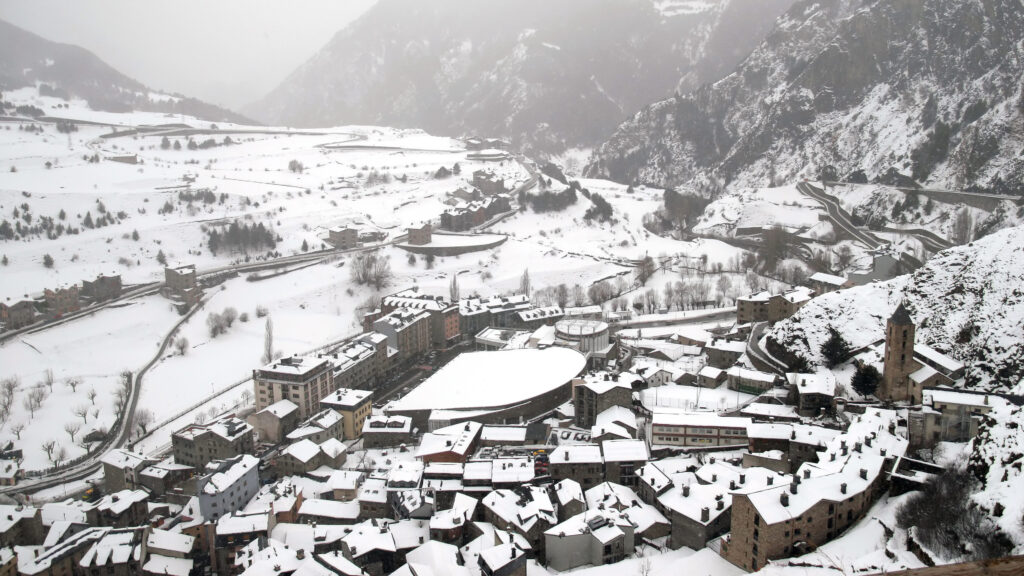
Vallnord is not just a single ski resort but a collection of several interconnected ski areas, including Pal, Arinsal, and Ordino-Arcalís. Each area offers its own unique terrain and facilities, catering to skiers and snowboarders of all levels. Pal and Arinsal are particularly popular for beginners and intermediate skiers, while Ordino-Arcalís is known for its off-piste and freeride opportunities. Apart from skiing and snowboarding, visitors can also enjoy activities like snowshoeing, snowmobiling, and sledding.
How to Get There:
Public Transport: From Andorra la Vella, travelers can take a public bus operated by Andorra Bus to La Massana, where they can access Vallnord via cable car or shuttle bus.
Private Transport: Taxis or rental cars offer direct transportation to Vallnord from Andorra la Vella.
Transportation Cost:
1. Public Transport: Bus fares are typically around €2-€3 per person one way.
2. Private Transport: Taxi fares may range from €15-€20 each way.
Must-Do Activities: Skiing, snowboarding, snowshoeing, snowmobiling, sledding, and enjoying après-ski activities such as dining and entertainment at mountain restaurants and bars.
Entrance Fee: Ski passes are required for access to the slopes, with prices varying depending on the duration and type of pass.
2. Caldea Spa Complex
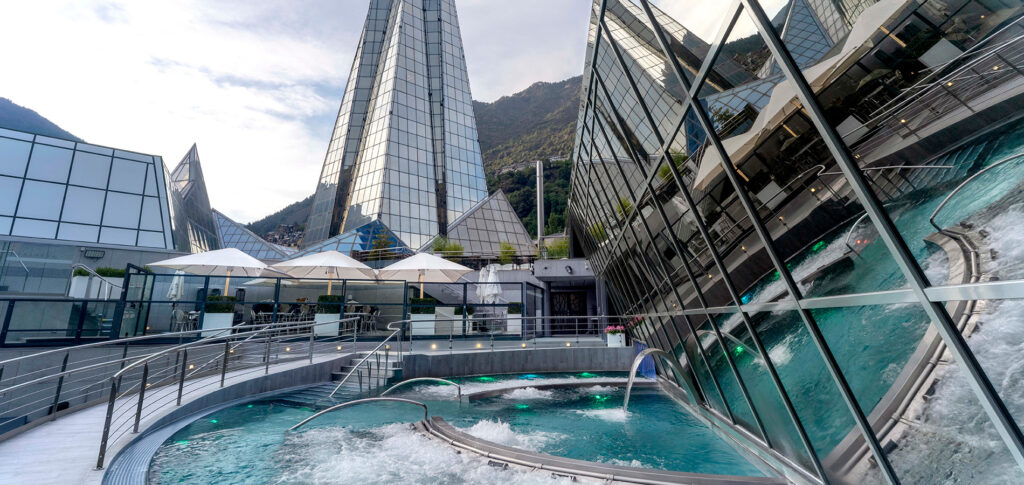
Caldea is not just a spa but an architectural marvel designed by renowned architect Jean-Michel Ruols. It features a striking combination of glass and steel structures, housing a variety of thermal baths, saunas, jacuzzis, and relaxation areas. The complex offers a range of spa treatments and wellness programs, including massages, facials, and hydrotherapy sessions. Visitors can also enjoy panoramic views of the surrounding mountains from the outdoor thermal pools.
How to Get There:
Public Transport: Buses run regularly from Andorra la Vella to Escaldes-Engordany, where Caldea is located.
Private Transport: Taxis or rental cars provide direct transportation to Caldea from Andorra la Vella.
Transportation Cost:
1. Public Transport: Bus fares are typically around €1-€2 per person one way.
2. Private Transport: Taxi fares may range from €5-€10 each way.
Must-Do Activities: Relaxing in the thermal pools, experiencing different spa treatments, enjoying panoramic views from the outdoor pools, and indulging in healthy cuisine at the onsite restaurants.
Entrance Fee: Admission fees vary depending on the time of day and package chosen.
3. Sant Joan de Caselles Church
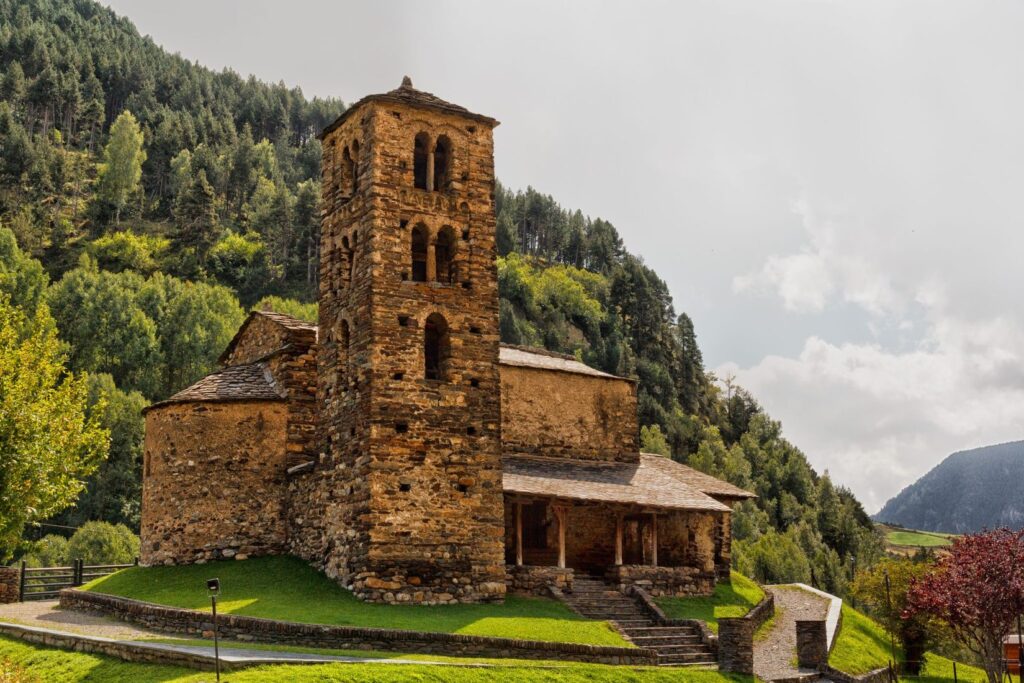
Sant Joan de Caselles is not just a historic church but a cultural landmark dating back to the Romanesque period. Its architecture reflects the Lombard style typical of the region, with a bell tower, nave, and apse adorned with decorative elements such as arches, columns, and frescoes. The interior features religious artifacts and artwork, including a Baroque altarpiece and medieval murals depicting biblical scenes.
How to Get There:
Public Transport: Buses operate from Andorra la Vella to Canillo, where Sant Joan de Caselles is located. From the bus stop in Canillo, it’s a short walk to the church.
Private Transport: Taxis or rental cars offer direct transportation to Sant Joan de Caselles from Andorra la Vella.
Transportation Cost:
1. Public Transport: Bus fares are typically around €2-€3 per person one way.
2. Private Transport: Taxi fares may range from €10-€15 each way.
Must-Do Activities: Exploring the interior of the church, admiring the Romanesque architecture and decorative details, attending religious services or cultural events, and enjoying panoramic views from the surrounding area.
Entrance Fee: There is no entrance fee to visit the church.
4. Madriu-Perafita-Claror Valley
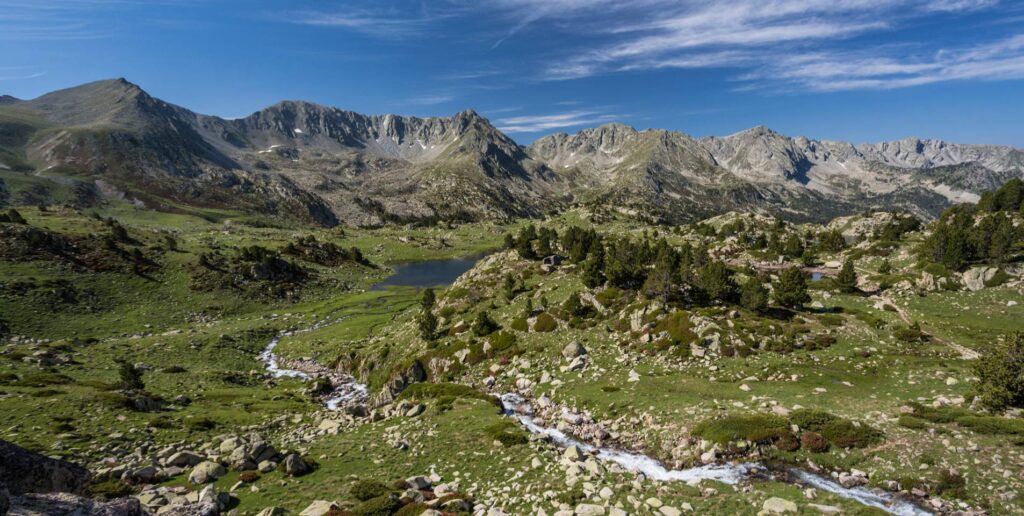
The Madriu-Perafita-Claror Valley is not just a scenic landscape but a UNESCO World Heritage Site recognized for its cultural and natural significance. It encompasses a diverse range of habitats, including high mountain peaks, alpine meadows, forests, and rivers, which support a rich variety of flora and fauna. The valley is also home to traditional stone-built cabins known as “bordas,” which are used by shepherds and hikers as shelters. Visitors can explore the valley via a network of well-marked hiking trails, offering opportunities for outdoor recreation, wildlife viewing, and photography.
How to Get There:
Public Transport: While there is no direct public transport to the valley, visitors can take a public bus from Andorra la Vella to nearby towns like Encamp or Escaldes-Engordany, from where they can access hiking trails leading to the valley.
Private Transport: Taxis or rental cars provide flexibility in exploring the valley at your own pace.
Transportation Cost:
1. Public Transport: Bus fares are typically around €2-€3 per person one way.
2. Private Transport: Taxi fares may vary depending on the distance traveled.
Must-Do Activities: Hiking along scenic trails, picnicking in natural surroundings, birdwatching, identifying wildflowers and wildlife, and capturing stunning photographs of the landscape.
Entrance Fee: There is no entrance fee to access the valley, but permits may be required for certain activities.
5. Andorra la Vella Shopping District
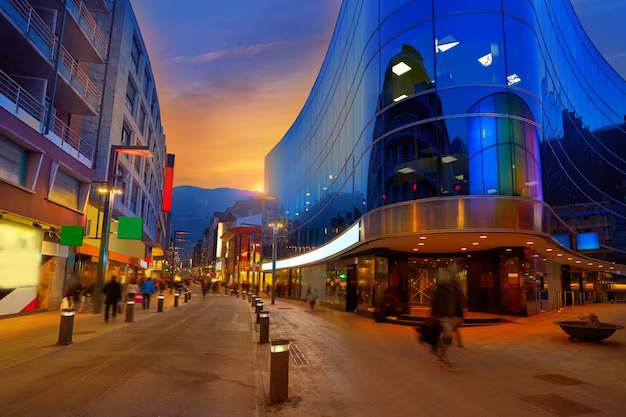
Andorra la Vella’s shopping district is not just a retail area but a shopper’s paradise known for its tax-free shopping opportunities. It features a wide range of stores, boutiques, department stores, and shopping centers offering an extensive selection of goods, including fashion apparel, accessories, electronics, cosmetics, perfume, jewelry, watches, sports equipment, souvenirs, and local handicrafts. Popular shopping destinations include the Illa Carlemany shopping center, Pyrénées department store, and Meritxell Avenue, which is lined with luxury boutiques.
How to Get There:
The shopping district is centrally located in Andorra la Vella and easily accessible on foot from most accommodations in the city center.
Transportation Cost:
No transportation cost is incurred when walking to the shopping district.
Taxi fares may apply for those opting for private transport.
Must-Do Activities: Shopping for duty-free goods, exploring local markets, sampling Andorran delicacies at cafes and restaurants, enjoying street performances, and taking advantage of special discounts and promotions.
Entrance Fee: There is no entrance fee to access the shopping district.
Hidden Treasures of Andorra: 5 Local Gems Off the Beaten Path
1. Estanys de Tristaina
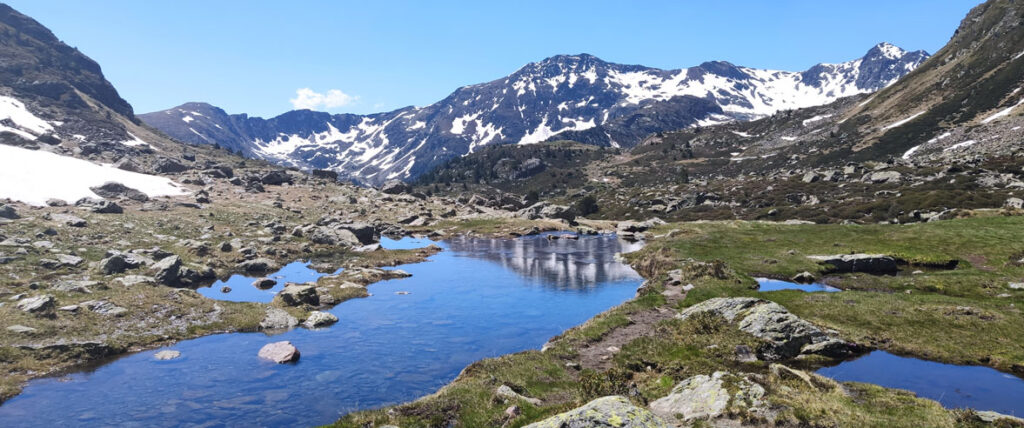
Estanys de Tristaina comprises a series of stunning mountain lakes nestled amidst the Pyrenees. Surrounded by breathtaking alpine scenery, these pristine lakes offer tranquility and natural beauty away from the crowds.
- How to Get There:
- Public Transport: From Andorra la Vella, take a bus to Ordino, then transfer to a bus heading towards Arcalís. Disembark at the Vallnord-Arcalís ski resort. From there, follow marked hiking trails to Estanys de Tristaina.
- Private Transport: Taxis or rental cars provide direct transportation to Vallnord-Arcalís ski resort.
- Transportation Cost: Public bus fares are typically around €2-€3 per person one way. Taxi fares may range from €15-€20 each way.
- Must-Do Activities: Hiking around the lakes, picnicking amidst the scenic surroundings, wildlife spotting, and photography.
- Entrance Fee: There is no entrance fee to access Estanys de Tristaina.
2. Coll de la Botella
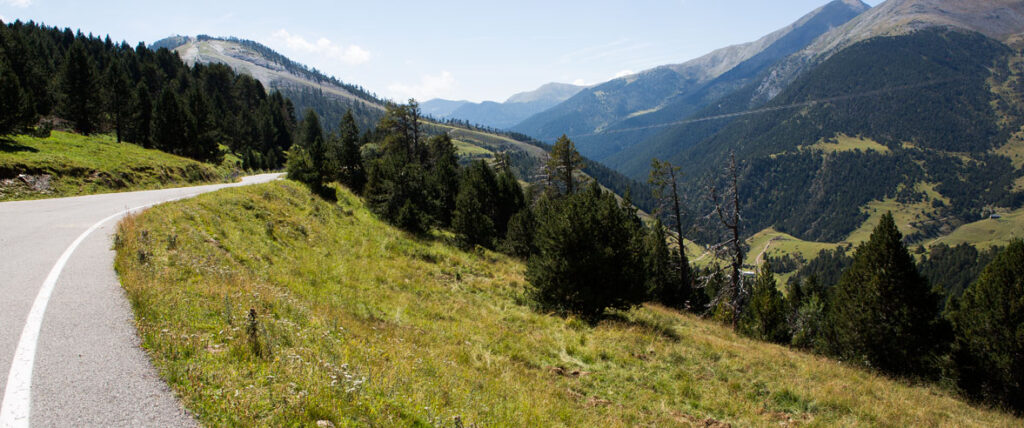
Coll de la Botella is a picturesque mountain pass offering stunning panoramic views of the surrounding valleys and peaks. It’s a hidden gem favored by locals for its tranquility and natural beauty, perfect for hiking and photography enthusiasts.
- How to Get There:
- Public Transport: From Andorra la Vella, take a bus to Canillo. From Canillo, follow hiking trails or hire a local guide to reach Coll de la Botella.
- Private Transport: Taxis or rental cars offer direct transportation to Canillo, from where visitors can access the mountain pass.
- Transportation Cost: Public bus fares are typically around €2-€3 per person one way. Taxi fares may range from €10-€15 each way.
- Must-Do Activities: Hiking to the mountain pass, enjoying panoramic views, birdwatching, and exploring nearby hiking trails.
- Entrance Fee: There is no entrance fee to access Coll de la Botella.
3. La Font de la Navina
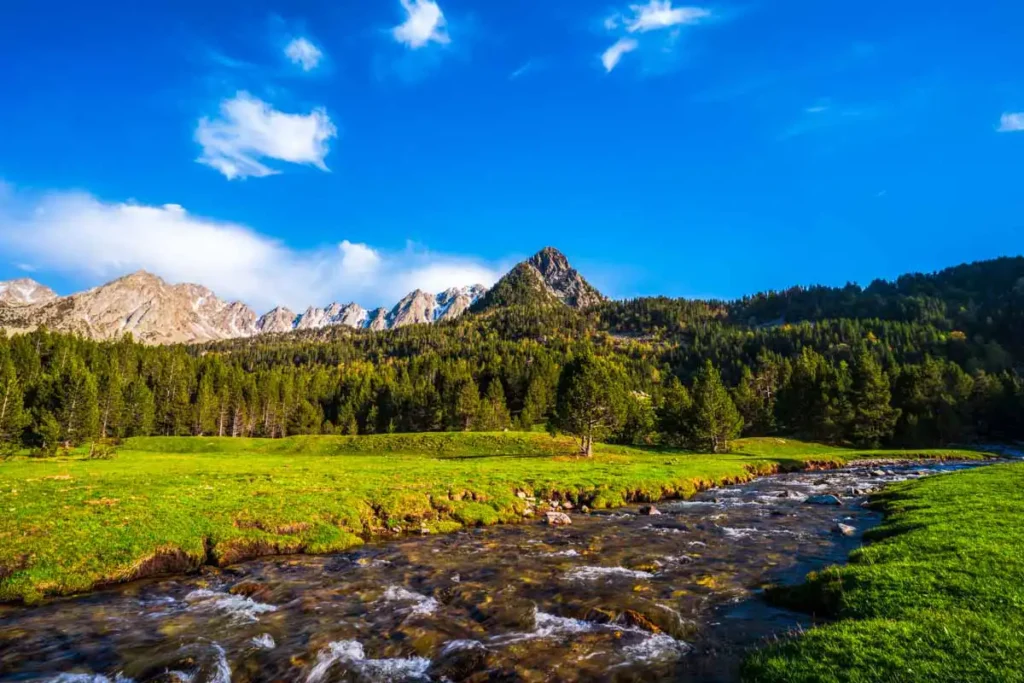
La Font de la Navina is a hidden natural spring nestled in the mountains near the village of Sornàs. Known for its crystal-clear waters and tranquil surroundings, it’s a peaceful spot where locals go to collect fresh mountain water.
- How to Get There:
- Public Transport: From Andorra la Vella, take a bus to Sornàs. From Sornàs, follow marked hiking trails to La Font de la Navina.
- Private Transport: Taxis or rental cars offer direct transportation to Sornàs village.
- Transportation Cost: Public bus fares are typically around €2-€3 per person one way. Taxi fares may range from €10-€15 each way.
- Must-Do Activities: Collecting fresh mountain spring water, enjoying a picnic by the stream, hiking in the surrounding area.
- Entrance Fee: There is no entrance fee to access La Font de la Navina.
4. Cortal de la Margineda
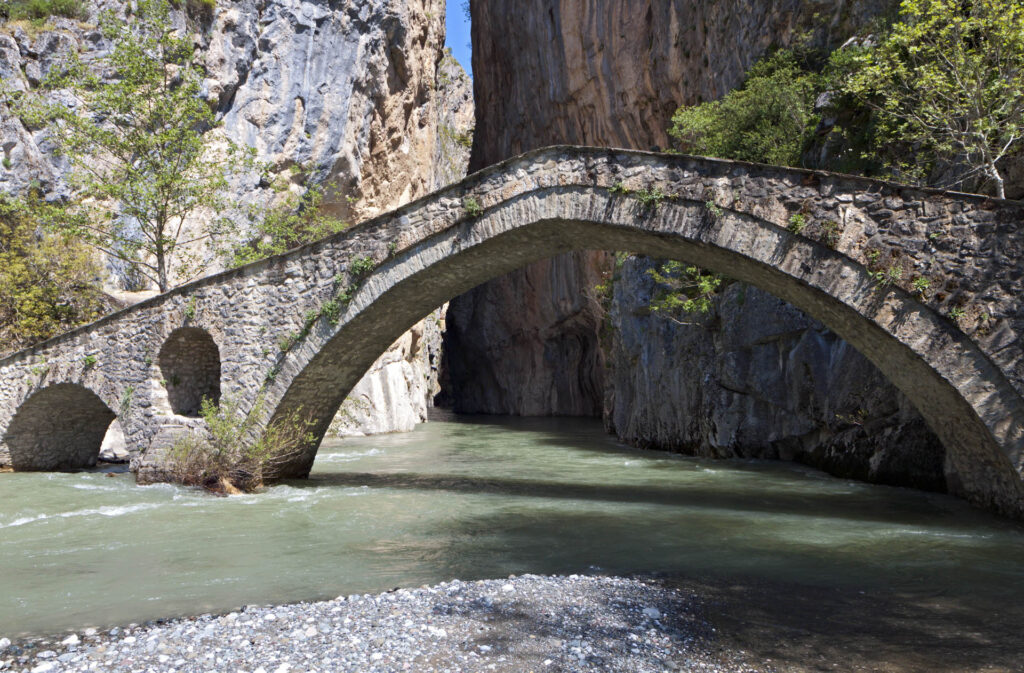
Cortal de la Margineda is a hidden valley located near the town of Andorra la Vella, known for its lush greenery, meandering streams, and scenic hiking trails. It’s a peaceful retreat away from the bustling city, ideal for nature lovers and outdoor enthusiasts.
- How to Get There:
- Public Transport: From Andorra la Vella, take a bus to Santa Coloma. From there, follow marked hiking trails to Cortal de la Margineda.
- Private Transport: Taxis or rental cars offer direct transportation to Santa Coloma.
- Transportation Cost: Public bus fares are typically around €1-€2 per person one way. Taxi fares may range from €5-€10 each way.
- Must-Do Activities: Hiking in the valley, exploring the scenic surroundings, birdwatching, and photography.
- Entrance Fee: There is no entrance fee to access Cortal de la Margineda.
5. Roc de la Coma d’Or
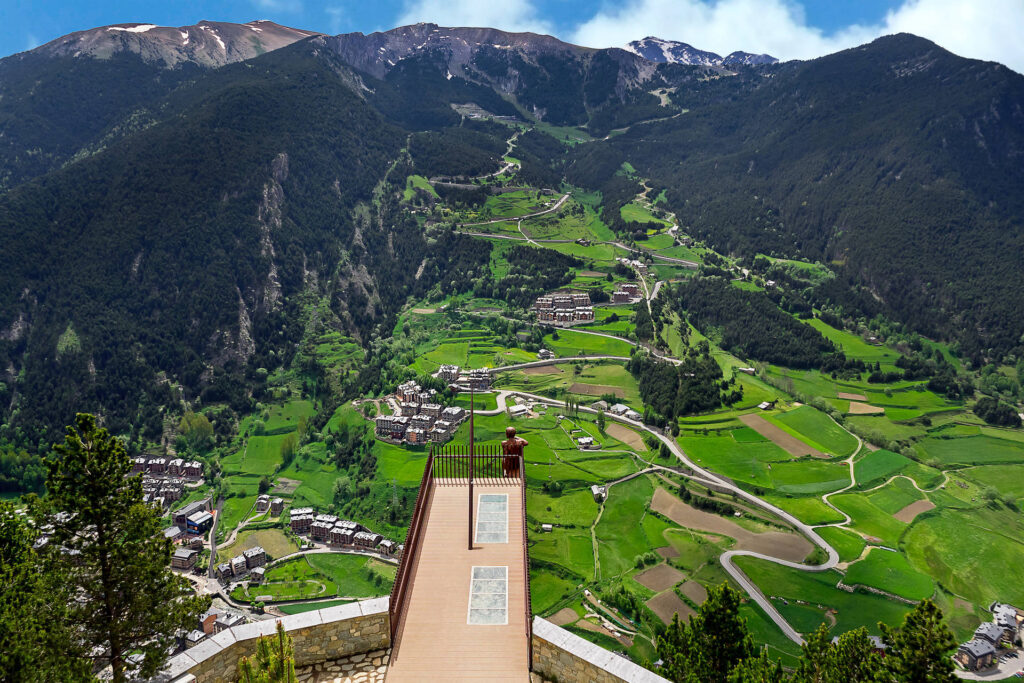
Roc de la Coma d’Or is a hidden viewpoint offering panoramic views of Andorra’s rugged landscapes and distant mountain peaks. It’s a serene spot favored by locals for its stunning sunsets and peaceful ambiance.
- How to Get There:
- Public Transport: From Andorra la Vella, take a bus to El Tarter. From El Tarter, follow marked hiking trails to Roc de la Coma d’Or.
- Private Transport: Taxis or rental cars offer direct transportation to El Tarter.
- Transportation Cost: Public bus fares are typically around €2-€3 per person one way. Taxi fares may range from €10-€15 each way.
- Must-Do Activities: Hiking to the viewpoint, enjoying panoramic views, photography, and watching the sunset.
- Entrance Fee: There is no entrance fee to access Roc de la Coma d’Or.
Transport: How to get there and roam around in Andorra?
Getting to Andorra: Best Routes and Modes of Transport
For travelers heading to Andorra, the primary entry points are through neighboring countries, Spain and France. The most common routes involve arriving at nearby airports or train stations and then continuing the journey to Andorra by bus or car.
- By Air:
- The nearest international airports to Andorra are Barcelona-El Prat Airport (BCN) in Spain and Toulouse-Blagnac Airport (TLS) in France.
- From Barcelona-El Prat Airport, travelers can take a direct bus operated by companies like Andbus or Novatel to Andorra la Vella, the capital of Andorra. The journey takes approximately 3-4 hours.
- From Toulouse-Blagnac Airport, travelers can take a shuttle bus or taxi to Toulouse Matabiau train station, then board a train to L’Hospitalet-près-l’Andorre, a town near Andorra. From there, they can take a connecting bus to Andorra la Vella.
- Budget Tip: Booking flights in advance and opting for budget airlines can help reduce costs. Additionally, choosing a flight that arrives early in the day allows more flexibility in connecting transportation options.
- By Bus or Car:
- Travelers can also reach Andorra by bus or car from nearby cities like Barcelona, Toulouse, or Lleida.
- Several bus companies operate services between major cities and Andorra la Vella. FlixBus, ALSA, and Eurolines are some of the operators offering routes to Andorra.
- Renting a car is another option for flexibility and convenience, especially for exploring remote areas of Andorra. However, be aware of additional costs such as tolls and fuel.
Modes of Transport in Andorra: Getting Around
Once you’ve arrived in Andorra, several modes of transport are available for getting around the country, each with its own advantages and costs.
- Public Bus:
- Andorra’s public bus network, operated by companies like Andbus and Cooperativa Interurbana Andorrana (CIA), provides extensive coverage across the country.
- Buses connect major towns and villages, as well as popular tourist attractions and ski resorts.
- Travelers can purchase single tickets or multi-journey cards, which offer discounted fares for multiple rides.
- Budget Tip: Consider purchasing a multi-journey card if you plan to use the bus frequently during your stay. It can offer significant savings compared to purchasing individual tickets for each journey.
- Taxi:
- Taxis are readily available in Andorra and can be hailed on the street or booked in advance.
- While taxis offer door-to-door service and flexibility in scheduling, they can be more expensive than other modes of transport.
- It’s advisable to negotiate the fare with the driver before starting the journey, especially for longer distances.
- Rental Car:
- Renting a car provides the ultimate flexibility for exploring Andorra’s scenic roads and remote areas.
- Several car rental companies operate in Andorra la Vella and other major towns, offering a range of vehicle options to suit different budgets.
- However, be aware of additional costs such as insurance, fuel, and parking fees.
- Walking and Cycling:
- Andorra’s compact size and picturesque landscapes make it ideal for walking and cycling.
- Many towns and villages are pedestrian-friendly, with well-maintained sidewalks and walking paths.
- Cycling enthusiasts can enjoy exploring scenic routes and mountain trails, with bike rental shops available in tourist areas.
Cost of Transportation for Budget Backpackers and Travelers
In terms of cost, public bus transportation is generally the most budget-friendly option for travelers exploring Andorra. Single bus fares typically range from €1.50 to €3 per journey, depending on the distance traveled. Multi-journey cards, offering discounted fares for multiple rides, are available for purchase and are particularly cost-effective for frequent bus users.
Taxi fares in Andorra are regulated by the government and are based on a metered system. The starting fare is around €2.50, with additional charges based on distance traveled and waiting time. While taxis provide convenience and door-to-door service, they can be more expensive than other modes of transport, especially for longer journeys.
Renting a car in Andorra is relatively affordable, with daily rental rates starting from around €30-€40 for a compact car. However, travelers should factor in additional costs such as fuel, insurance, tolls, and parking fees when budgeting for their trip.
Quality of Travel and Potential Difficulties
In general, the quality of public transportation in Andorra is reliable and efficient, with well-maintained buses and a comprehensive network of routes covering the entire country. Bus schedules are generally punctual, and drivers are helpful and knowledgeable about the routes.
However, travelers should be aware that Andorra’s mountainous terrain and winding roads can sometimes lead to longer journey times, especially during inclement weather or peak tourist seasons. Additionally, limited options for transportation to remote areas or off-the-beaten-path destinations may require careful planning and flexibility in itinerary.
Budget Traveler’s Guide to Andorra: Tips, Tricks, and Must-Knows
Visa Process and Restrictions: Entry Requirements
- Andorra is not part of the Schengen Area, so travelers should check visa requirements based on their nationality.
- American citizens can visit Andorra visa-free for up to 90 days within a 180-day period.
- Ensure passports have at least six months’ validity beyond the intended stay.
Things We Shouldn’t Do: Cultural Etiquette
- Avoid disrespecting local customs or traditions.
- Refrain from littering or damaging natural landscapes.
- Keep noise levels down, especially in residential areas.
Currency and Money-Saving Tips: Managing Finances
- Andorra uses the euro (EUR). Exchange money at banks or ATMs for the best rates.
- Save money by dining at local eateries rather than tourist restaurants.
- Look for budget-friendly activities such as hiking or exploring Andorra’s natural beauty.
Budget Accommodations: Affordable Places to Stay
- Opt for budget hostels or guesthouses in towns like Andorra la Vella, Pas de la Casa, or Soldeu.
- Consider shared accommodations or dormitory-style rooms for lower rates.
- Look for accommodations away from ski resorts for better deals, but ensure easy access to public transportation.
Local SIM Provider and Best Plan: Staying Connected
- Andorra Telecom offers prepaid SIM cards for tourists with varying data and call packages.
- Purchase SIM cards from Andorra Telecom stores or authorized retailers.
- Compare data plans for tourists to find the most suitable option based on duration of stay and data needs.
Basic Words in Local Language: Useful Phrases
- Hello: Hola
- Thank you: Gràcies
- Please: Si us plau
- Goodbye: Adéu
- Yes: Sí
- No: No
- Excuse me: Perdó
Local Cuisine and Must-Try Foods: Gastronomic Delights
- Try traditional Andorran dishes like Escudella, a hearty meat and vegetable stew, or Trinxat, a potato and cabbage dish.
- Sample local cheeses such as Tupí or Serac, often served with crusty bread.
- Explore budget-friendly tapas bars or cafés for affordable dining experiences.
- Set aside around €10-€15 per person for a meal at a mid-range restaurant, but street food or casual eateries offer cheaper options.
Modern-day Andorra: Navigating Political and Economic Realities
Political Landscape:
Andorra operates under a parliamentary co-principality, with the President of France and the Bishop of Urgell (Spain) serving as co-princes. This unique governance structure has remained stable, providing a foundation for the country’s political landscape. Additionally, Andorra transitioned to a constitutional democracy in 1993, further solidifying its political framework.
Economic Landscape:
Andorra has a robust economy driven primarily by tourism, finance, and trade. Its status as a tax haven attracts international businesses, while its scenic landscapes draw tourists year-round, particularly for skiing and hiking. Additionally, Andorra’s strong banking sector contributes significantly to its economic stability.
Recent Developments:
In recent years, Andorra has undertaken various initiatives to diversify its economy and promote sustainable development. One notable development is the country’s efforts to enhance its digital infrastructure and position itself as a tech-friendly destination. Initiatives such as promoting e-commerce, investing in digital education, and fostering innovation have been priorities for the government.
Furthermore, Andorra has made strides in environmental conservation, aiming to protect its natural landscapes while capitalizing on eco-tourism opportunities. Sustainable tourism practices, including eco-friendly accommodations and outdoor activities, have gained traction, aligning with global trends towards responsible travel.
Challenges and Issues:
Despite its economic prosperity, Andorra faces several challenges in the modern era. One significant issue is its heavy reliance on tourism and finance, leaving the economy vulnerable to external factors such as global economic downturns or shifts in tax regulations.
Additionally, Andorra grapples with the need to balance economic growth with environmental preservation. As tourism continues to drive development, concerns arise regarding overdevelopment, strain on natural resources, and the impact on local ecosystems.
Moreover, Andorra must navigate geopolitical complexities, given its position between France and Spain. While the country maintains friendly relations with its neighbors, it must remain vigilant to external pressures and geopolitical dynamics that could affect its sovereignty and economic interests.
Wanderer’s Word
In conclusion, exploring modern-day Andorra reveals a nation with a resilient political structure and a thriving economy deeply rooted in tourism and finance. Recent initiatives aimed at diversifying the economy and embracing technology underscore Andorra’s commitment to sustainable growth and development. However, challenges such as overreliance on tourism and environmental conservation efforts remain pressing concerns. Yet, amidst these challenges, Andorra’s unique governance system and breathtaking landscapes offer a beacon of hope. By balancing economic progress with environmental stewardship and maintaining diplomatic relations with neighboring countries, Andorra is poised to navigate the complexities of the modern era while preserving its cultural heritage and natural beauty for generations to come.
"Traveling broadens the mind."
